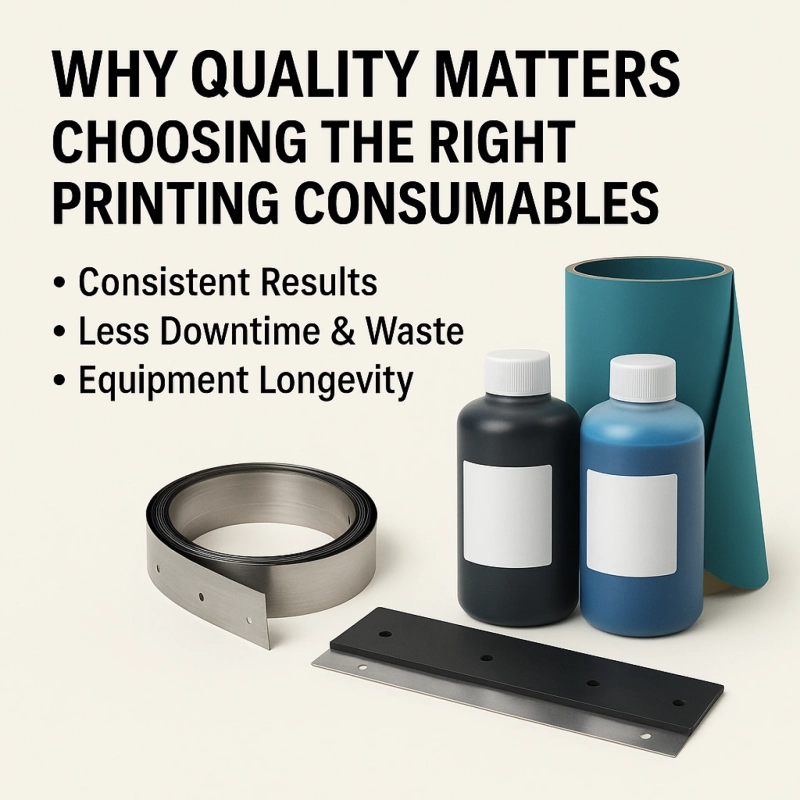When it comes to professional printing, one key factor can make the difference between average and outstanding results: quality printing consumables. Whether you're running a large commercial operation or a smaller local print business, the materials you use daily—inks, blades, blankets, and filters—have a direct impact on the consistency and quality of your output.
Yet, these everyday essentials are often overlooked. In reality, choosing the right print shop supplies isn’t just about keeping your machines running—it’s about maintaining consistency, reliability, and customer trust.
The Role of Printing Consumables in Quality Control
Let’s face it—no matter how advanced your offset press is, it’s only as good as the consumables it runs on. From blanket wear to ink duct foils, every small component plays a big role in how your final product turns out.
Here’s why quality matters:
1. Consistency Across Every Print Job
High-quality printing consumables deliver better ink transfer, sharper images, and more consistent color profiles. They’re built for precision, which means fewer variations—even on long print runs.
2. Less Downtime, Less Waste
Cheap or poorly made consumables often wear out faster. This leads to unexpected press stoppages, increased plate changes, and higher paper waste. Investing in better materials reduces interruptions and keeps your workflow smooth.
3. Equipment Longevity
Press components are expensive. Using low-grade or incompatible consumables can cause damage over time—especially with items like wash-up blades or ink foils. Quality consumables help you avoid costly repairs and extend the life of your equipment.
What to Look for in Offset Printing Consumables
Not all offset printing consumables are created equal. If you’re aiming for consistent, high-performance output, here’s what you should evaluate:
- Material Quality
Choose duct foils made from pure PET resin or wash-up blades that resist corrosion. These materials last longer and produce cleaner results.
- Fit and Compatibility
Consumables should match your specific press models and ink types. Check for sizing precision and OEM references to ensure a proper fit.
- Thickness and Durability
For example, duct foils come in various thicknesses. Thicker variants are ideal for UV inks and longer runs, while thinner ones may suffice for short-term, standard jobs.
- Environmental Impact
Sustainability is becoming more critical in the print industry. Where possible, opt for inks and papers that are eco-certified and responsibly manufactured.
The Business Case for Better Print Shop Supplies
It’s tempting to cut costs by sourcing cheaper supplies, but the long-term effects can hurt your margins.
High-quality print shop supplies might come at a higher upfront price, but they result in:
- Fewer misprints and re-runs
- Lower maintenance costs
- Better client satisfaction
- Less wasted paper and ink
Over time, the total cost of ownership is actually lower, and your output is consistently impressive.
Real-World Scenarios: What Happens When You Upgrade
Professionals in the field consistently report that upgrading their printing consumables results in:
- Faster setup times (thanks to better blankets and foils)
- Improved color consistency across batches
- Fewer complaints or reprints due to quality issues
- Reduced technician interventions for wash-up or maintenance
If you’re running on tight schedules and demanding specs, quality supplies aren't optional—they're essential.
Final Thoughts: Quality Isn’t a Luxury, It’s a Strategy
No matter the size of your printing business, focusing on quality is always a smart move. Choosing the right printing consumables helps you maintain consistent output, reduce errors, and keep your equipment running smoothly.
It’s not just about getting the job done—it’s about doing it well, saving time, and making sure your customers are satisfied with every print. By investing in reliable materials, you're building a foundation for better performance, fewer disruptions, and long-term success in your print operations.


